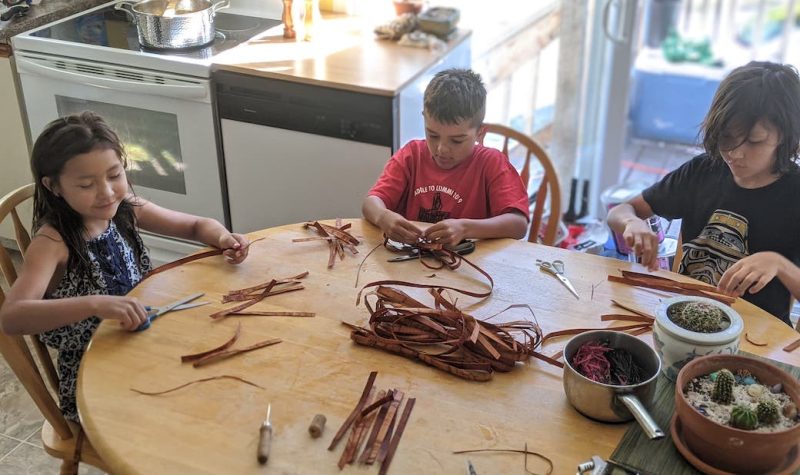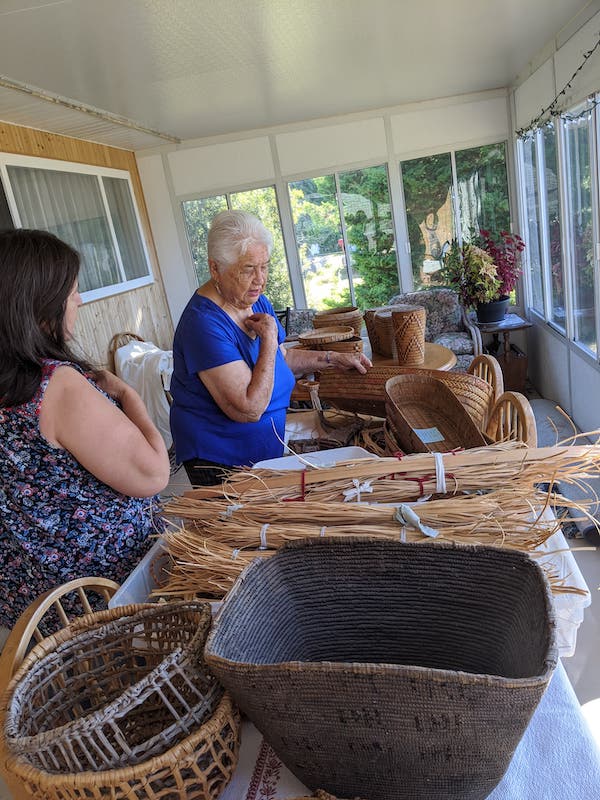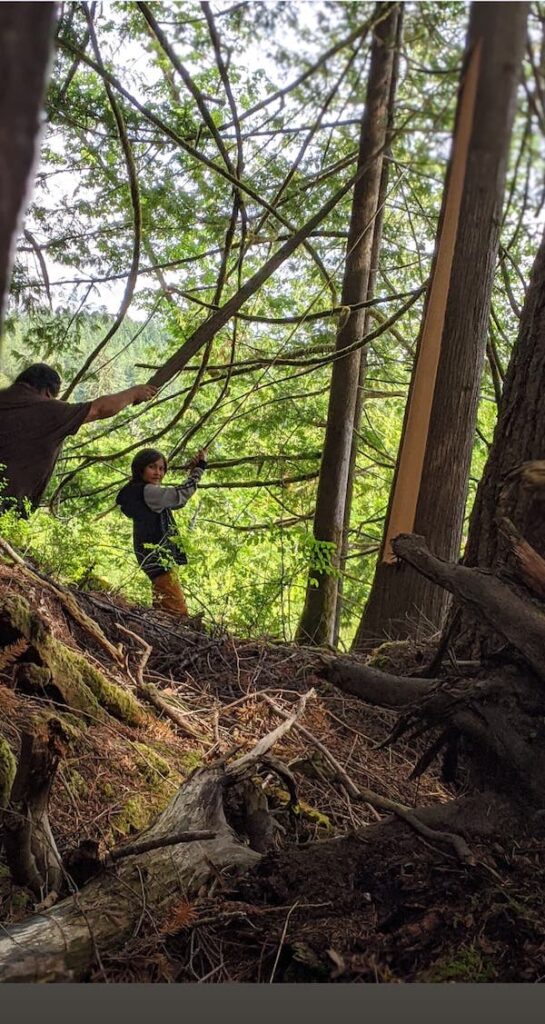By Odette Auger
Sosan Blaney is an Indigenous woman, artist, mom, wife. She’s also a very talented Tla’amin weaver. Sosan came to Klahoose to teach weaving workshops before COVID-19 interrupted. In this story we’ll catch up with Sosan and what she’s been doing during COVID-19.
‘Cultural resource library coordinator’’
Odette: Hi, Sosan. You’re a talented artist and weaver. Can you tell me about your work life also though? Tell me about your work in the schools.
Sosan Blaney: So my official job…is cultural resource library coordinator at the Tla’amin Child Development Resource Center. Sounds pretty fancy. I just run the cultural programming through the daycare. And I do a lot of outreach with the schools. I was mandated to work with ages zero to six. So it was a lot of early childhood education for the past… Oh, I guess seven or eight years now. But it’s recently changed to a more broader age group, which was nice because then I can branch out to older groups. And so I do that part time. And then I do a lot of work with the school district and different programming.
We have some wonderful programming, School District 47 at the Outdoor Learning Center that we have here. So the weaving and wild crafting program that I’ve been doing for… I don’t even know how many years now, where kids come in and they learn about some wild crafting at the Outdoor Learning Center. We do some rope and learn about plant dyes and plant medicines and stuff like that and do a little bit of harvesting. So it’s a really wonderful program. And then we had another one that was planned to start in spring time called the… Original Orchestra which is about finding music and nature. And it was really kind of based in Tla’amin teaching.
But of course that was canceled. It was going to be our first year this year, but that didn’t happen. Hopefully that can get up and running again when things are a little bit more back to normal.
Of course I do a lot of work for myself and just make baskets and hats and bead work and stuff like that.
Workshops at Klahoose
Odette: Tell me about the workshops you were teaching at Klahoose before COVID. Are they small groups and what age range?
Sosan Blaney: I’ve taught so many workshops at Klahoose over the past few years, and they’ve ranged from groups of eight to much larger than that. I think our highest total was 19 or something. 19 have stayed on a weekend. Something like that. So it kind of ranged. Everybody’s always been super interested and super welcoming to me come there. I love going to Klahoose to teach weaving workshops. It feels like my second home over there. The hospitality of our relatives over in Klahoose is just… it’s so good and so amazing. I love going there. I was supposed to teach a workshop there over spring break. I think it was the last weekend of spring break this year. And once again that got canceled due to COVID-19, which is unfortunate.
How old are your students?
Odette: Just circling back to that. What are the age range? Do you have youth there? Do you have elders?
Sosan Blaney: It’s always been a mix of ages. I’m trying to think of how old Royce was when he wove his first hat with us. I think he was… The first year they moved there…I feel like he was ten. Maybe?
Odette: I tutored him that year. I think he was ten.
Sosan Blaney: Yeah. So he was probably the youngest that has made a hat. I’ve done little things with some of the kids in there. They’re there a couple of times. They just love stuff like that. And then all the way up to the elders of the community would come out to weave. It’s really been all ages. And I really liked that. I’ve been bringing my kids over there to teach weaving workshops. And they were really little. I was just looking at some pictures from a workshop when Mekwan was a baby and my mom was there with me because she often comes too. It’s kind of a family affair and she’s wearing Mekwan in a baby carrier, helping me teach a weaving workshop. And other people bring their kids too. It’s a really good sense of community.
How did it all begin?
Odette: So when you started going, had everyone in the room weaved before or is it mixed levels or sometimes are your classes an introduction?
Sosan Blaney: I’m trying to think. That very first workshop was so many years ago… I think maybe there was a little bit of weaving experience, but often it’s a mix of experience levels. Sometimes there’ll be people who’ve never woven anything before or have never woven a hat before. And then now there’s quite a few very experienced members now over in Klahoose which is really exciting to see people who have really taken to the art form and spend their own time creating. And I really love seeing that and I love getting messages from people and saying, “Hey, this is what I’m working on. Check it out”, or if they need help maybe in edging, I really don’t mind people messaging me to help figure that stuff as well. Yeah. So it’s kind of a mix.
Odette: Sounds beautiful. So, your numbers of the group, I heard that depends on if you have your co-teacher or help? And it’s usually your mom. Did she teach you or did you learn together? Tell me about how that started.
Sosan Blaney: My mom. One of the reasons I love my mom. She’s always really indulged my need to create things. And so she, when I was a kid, did a couple intro to weaving courses and I’m talking specifically cedar bark. And so she taught me how to make little bracelets and baskets and stuff. And then with the hats which is usually what I go over to Cortes to teach is the hat making. That, I kind of figured out with a few other people when we’re at camp Au’puk’wum And I don’t know if you’re familiar with camp Au’puk’wum.
So, camp Au’puk’wum is or was a camp that was held in Forbes Bay, which is a reserve for the Klahoose people. It’s one of their… It’s their territory.
And it ran every year through my adolescence and youth. And there’re so many fond memories of that plot and often it was a group Tla’amin and Klahoose or sometimes Tla’amin would be there first or Klahoose would be there first, for Tla’amin to connect.
And when I was 13, we wanted to weave hats. So we… I already knew how to weave bark baskets and stuff. We had some bark that we’d harvested up in Forbes Bay and we made a hat mold out of those silver bowls, like a bread bowl. And cereal boxes and duct tape. And figured out how to weave from there. And then of course, since I’ve learned from other weavers. Since then the local hat weaving, me and my mom have kind of learned together on that and with cedar bark and then we learned together to weave in roots when I was an even younger child.
COVID-19
Odette: So COVID-19 affected your kid’s school. So they’ve been home with you since spring break. Did you weave alongside them or did you weave when they were asleep or busy doing other things?
Sosan Blaney: I’ve been really trying to teach them more because it’s really been, for me, weaving and beading and stuff like that… It’s really been almost like a meditation time for me, like an active meditation where I can just sit and be and create. And oftentimes when you’re teaching children, it can be a little bit frustrating. But I really, really want them to learn. Especially my daughter. She really has always been interested from the time an infant can show interest in some things. She’s always been interested in helping me weave and there’s so many pictures of her sitting on my lap, weaving with me and helping me prep bark. Maybe help in quotation marks.
So since COVID-19 has happened and we’ve really been at home doing a lot of home learning, I’ve tried to make more of an effort to include them in the processing and some of the weaving as well. They’ve always come to harvest with me though. The first time Menat’they, my son, went harvesting with me… the oldest… he would have been maybe a month and a half old. Just tiny. On my chest as I was pulling bark until this year. He’s graduated to using the tools to make the cuts from the tree and pulling the bark himself. So that’s something that we’ve worked up to now that he’s nine. So he can use a knife and a little hatchet as well. And that was new this year for him.
Odette: So what about COVID and elders? For me, it’s really raised awareness on protecting elders and language and culture that they are the keepers of. Were you able to continue weaving with elders at all?
Sosan Blaney: So, not really in the beginning. In the beginning, we really closed down and there wasn’t a lot… I didn’t even really do a lot with my parents through March and April. And then as things started to relax, it’s more with my parents. I don’t know if they would consider themselves elders. My dad’s in his early sixties and my mom’s late fifties. And then later on when things relaxed some more in July and August, weaving with my great aunt Elsie Paul , which was really nice to do.
To be able to sit on her sundeck and get back to root weaving, which I hadn’t done in years. It’s a lot harder and it’s a lot more work and it’s a lot more time consuming to do the root weaving than it is to do the bark weaving. So being able to sit with Elsie and weave was such a treat this summer. And of course, now we’re totally shut down again in a total lockdown. Not even a voluntary lock down, but an actual lockdown here at Solomon. Yeah, so I don’t think that’ll be happening again any time soon because we just want to protect our elders and our knowledge keepers. It’s so important that we learn from them, but also at times like this we protect them.
Odette: I’ve been following the news and hoping for the best for your community.
Sosan Blaney: Yeah. It’s scary times. It’s hard not to be anxious or panic about it, but I think we’ll… It’s really amazing to see the community come together and be strong and provide for each other at this time. It’s been really amazing to see.
When do you weave?
Odette: So I was going to ask about when you were weaving on your lawn or when you’re at the beach or you’re even weaving when you go camping. And I imagine that would attract some attention and people joining in. Am I right?
Sosan Blaney: Yeah, it really does. I have a hard time keeping my… with idle hands. I tend to always have something going, some project going. And I have this one basket that I carry around with weaving supplies in it. And if I’m going somewhere like a music festival or even on a ferry ride or planned a picnic or something, so then I’ll usually take something just to work on. Whether that’s a weaving or beading, I’ll take my little beading kit with me because those are kind of the two portable things that I can bring with me. But it does attract attention and sometimes it’s good engagement and sometimes it’s just a little gawking, but mostly it’s positive. And yep, people can join in sometimes but it kind of depends. There’s relationships and reciprocal relationships.
And sometimes you can form those quickly and sometimes it feels like there’s less give and take there. And this summer when we met some people camping that I would consider friends now and we’ve kept in touch with, and they joined in with some of our weaving. And with the kids, they did some weaving together and some sharing together. And boy, did those kids love sharing stories with each other. But it was really amazing to see. We got to weave and share traditional stories as well around the campfire. And yeah, that was good.
Odette: I really like that. It sounds like because you are weaving and you are engaging in something traditional that the kids would connect on a different level than say if they’re playing video games or even playing soccer or something.
Sosan Blaney: – Mm-hmm (affirmative). Yeah, and maybe it’s because we’re sitting and our hands are busy, they… How do I put this? The willingness to share their stories and what’s on their mind and stuff like that seems to be easier for kids when they’ve got something in their hands. And I’ve noticed that in some of the school programming I do where sometimes we get like, “Oh, be careful with this class. This class is known to be a rowdy bunch of boys”, but then you get them and you put some cedar bark in their hands and teach them how to make rope. And they are so focused and they’re so calm and they’re so into it. And they’re willing to share parts of themselves with you through that connection. And it’s really… When that magic happens in the school group, I really, really like it. It’s a good feeling. It’s an amazing kind of magic to see happen with some of those students.
Where can people see your weaving?
Odette: That makes me smile. It’s essential that we give our youth those opportunities. So I’m curious where people can see your weaving recently or upcoming. Do you have any displays or stores? And I’m curious about commissions. I know you do some commission work. Where would people contact you for that?
Sosan Blaney: I get asked this question a lot. You’d think after how many years of weaving, I’d have a better answer, but I don’t really do that. I rarely put my stuff into stores and galleries. I think I’ve only ever shown them once. I did once enter the Artique, which is an artist collective in Powell River, but mostly I just post it on Instagram and people buy from there. So, it’s mostly just social media, sending it out… or I’ll be sitting somewhere and I’ve just finished weaving a hat and somebody will be like, “Hey, can I buy that?”.
Yeah, I haven’t really taken it on as a full time job, or a full time gig for myself. It’s more… I find joy in creating things and sending that out to people. And when I have put that pressure on myself to keep a commission or something like that, it’s become less fun. So it’s mostly just word of mouth and I will take the occasional commission if I’m in the right head space. And I’ll make up a bunch of stuff and I’ll do a flash sale on Instagram or Facebook. And usually within 24 to 48 hours they sell out.
Odette: I think that’s a testament to your good energy that you’re putting into your work, if it’s just coming your way. So it sounds like you have an Instagram account that people could keep an eye on and just see what you’re doing and see some of the beautiful work and also potentially catch one of your flash sales that come up from time to time.
Sosan Blaney: Yeah. It’s Sosannna with three N’s.
Odette: S-O-S-A-N-N-N-A on Instagram.
Sosan: I just recently posted a whole bunch of beaded earrings on there. I’ll occasionally do a raffle because I understand something like a hat can be really expensive for people. So, I’ll raffle one off. People can afford a $5 raffle ticket. Mostly just posting stuff on there.
Odette: Okay. Well thank you for sharing this conversation with us and we’d love to follow you [on IG] and catch up with you later after COVID[-19] passes by us. Maybe we can catch up with you at one of those Klahoose workshops again.
Sosan Blaney: Yeah. I’m hoping we can make up for the one that we had to cancel.
E’mote.




